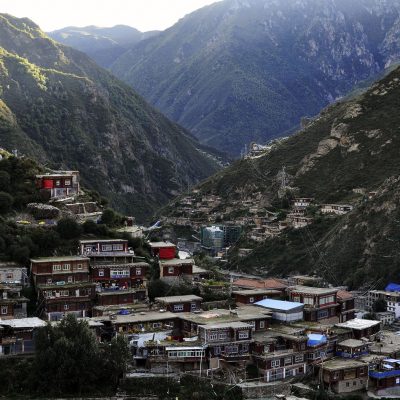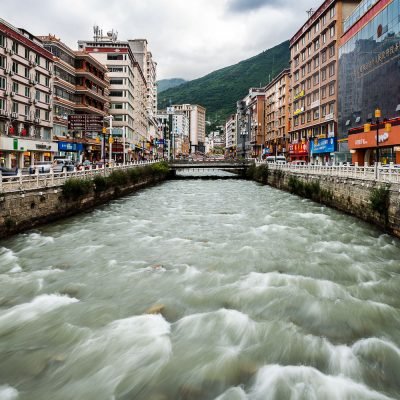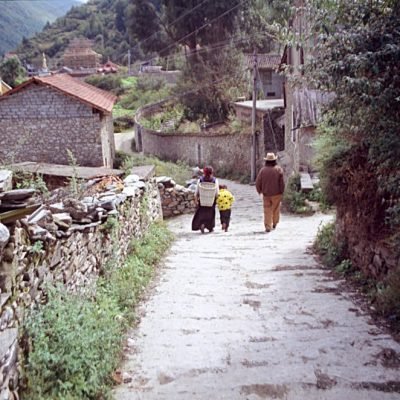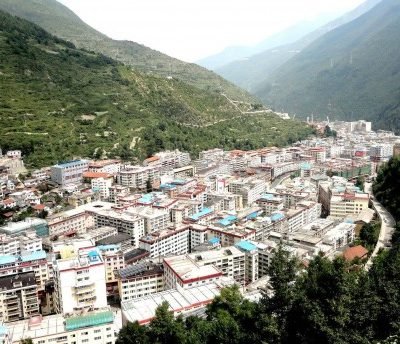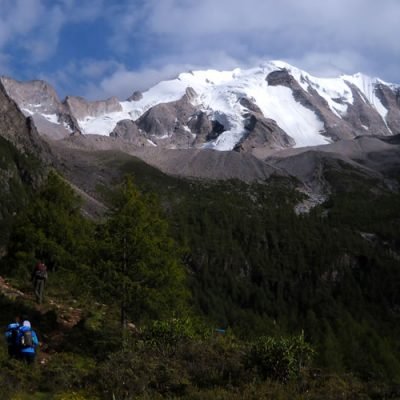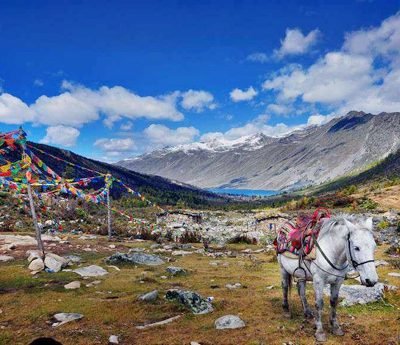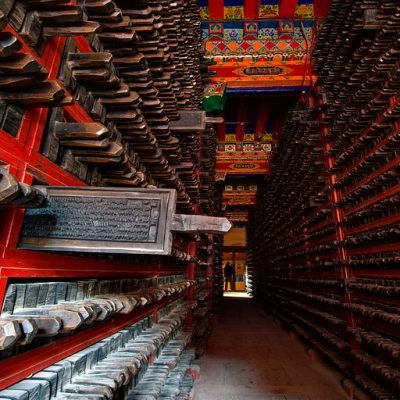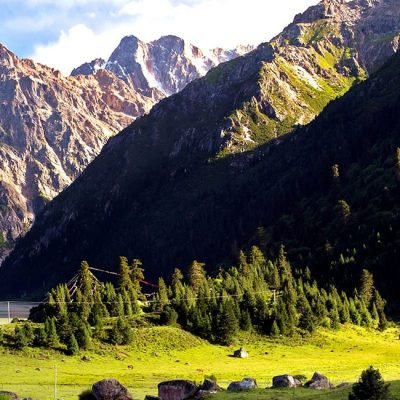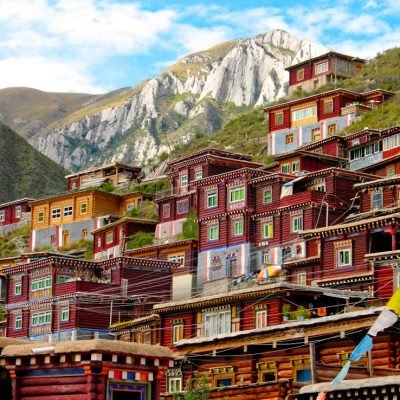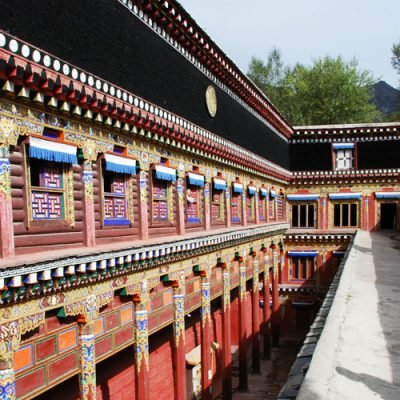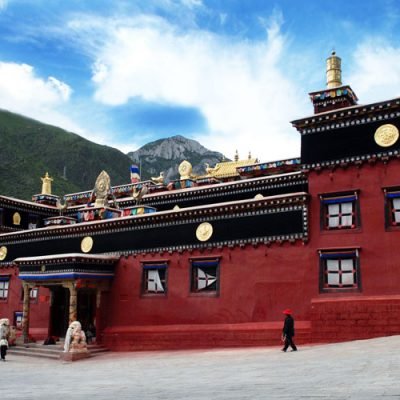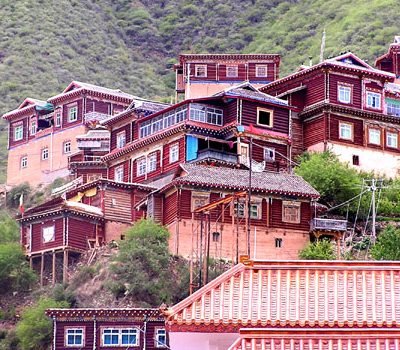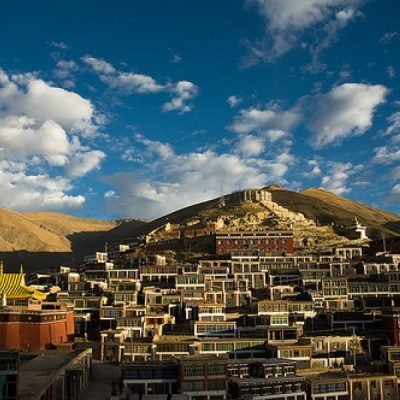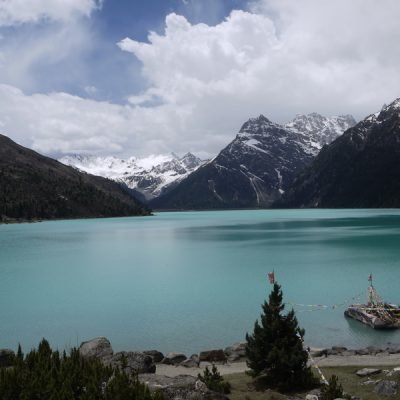Day 1 → Arrive in Chengdu
We will begin our journey Chengdu, the capital of Sichuan Province with over 14 million people. Chengdu is the hub of western China as the largest railway hub in the world and is famous for some of the best food in China, characterized by hot peppers and numbing seeds (but don’t worry- there are foods for all palettes, even those not particular to spicy cuisine!).
We will sleep in a hotel right across from the Chengdu airport.
Day 2 → Chengdu - Kangding
Today we will drive 325km out of the heart of the Sichuan basin’s "Land of Abundance" from Chengdu to Kangding and see bamboo forests and tea plantations along the way. We will follow the steps of the ancient Chinese porters as they carried loads of tea weighing 200 pounds per person for trade into the Tibetan Plateau. After experiencing a mind-boggling variety of landscapes from 500 m (1,600 ft) in Chengdu we will arrive in Kangding at 2,560 m (8,400 f).
At night we will visit Kangding’s Ngachu Monastery, followed by a Tibetan community circle dance in the local square (feel free to join in!)
We will sleep in a hotel in Kangding
Day 3 → Day hike around Kangding
We wake up in the cozy hotel to a nice breakfast. From there we take off for a day hike from 2,600 meters to 3,100 meters. This hike includes about 4 hours of total round trip hiking and departs immediately behind the hostel we are staying in up to a beautiful pasture where we will get our first views of the extraordinary Minya Konka range. This will be a great way to acclimatize for the upcoming trek as well as get a taste for the mountains. We will arrive back in town in time for a traditional Tibetan dinner in Kangding.
We will sleep in a guesthouse in Kangding.
Day 4 → Kangding - Tagong
After another delicious breakfast, we depart Kangding on a 3 hour drive up to 3,700 meters to a very unique Tibetan town called Tagong. Tagong is famous for it’s grassland cowboys and its elegant stone architecture. Along the way we will stop at snowy pass at 4,200 meters with an extraordinary mountain view from a Buddhist pagoda full of colorful prayer flags. In Tagong we will explore the town monastery and then drive another 20km to see the Ane Gompa Nunnery with one of Sichuan’s largest mani stone piles. Hundreds of Tibetan pilgrims visit this site everyday to walk around the nunnery and seek healing near the sacred stones.
We will sleep in a hotel in Tagong.
Day 5 → Tagong - Drango
From Tagong, we will travel 180 kilometers (112 miles) from the high grasslands, famous for their horse races and strong horses, to the farming villages of Drango (Luhuo in Chinese). Along the way we may get a chance to experience the barley crops and harvest of a few simple farming villages. We will sleep in Luhuo town at 3,200m (10,500 feet).
We will sleep in a simple but clean hotel in Drango.
Day 6 → Drango - Garze
Today we drive 95 km (60 miles) to Garze town at 3,360 m (11.025 feet). Garze contains a lively market and will explore the Ganzi Monastery. This is known as Ganzi Gompa in Tibetan and is found at the north end of the town and belongs to the Gelugpa sect of Tibetan Buddhism. With over 1,500 monks, the Ganzi Monastery is the largest Gelugpa religious site outside of the Litang and Chamdo Monasteries in the Kham region. The halls and terraces of the monastery offer amazing views of the surrounding beautiful valley with its lofty hills and the bustling Ganzi town.
This 540-year old monastery is adorned with a considerable amount of gold. The walls of the grand main hall are lined with hundreds of small golden Buddha statues (Sakyamunis) while an inspiring, large statue of the Maitreya or Future Buddha clad in a silk robes stands in a smaller hall to the west of the main hall. With many resident monks and devotees from the town and nearby areas circling the little chapels with giant prayer wheels, the temple is bustling throughout the day.
We will sleep in a hotel in Garze town.
Day 7 → Garze - Pelyul and Yarchen Gar Monastery
High in the mountains of Sichuan province, more than 10,000 Buddhist monks and nuns live in the austere surroundings of the Yarchen Gar monastery. Here, they follow the teachings of leader Asong Tulku, who counsels meditation and atonement for his disciples, and is revered as a living Buddha.
Established in 1985 by Lama Achuk Rinpoche, Yarchen Gar – officially known as Yaqing Orgyan – is located in Baiyu county, in western Sichuan’s Garzê Tibetan Autonomous Prefecture. At 4,000 metres above sea level the difficult-to-reach monastery boasts one of the largest congregations of monks and nuns in the world.
Despite modern improvements, hardship remains fundamental to the philosophy at Yarchen Gar. For 100 days every winter, each nun will inhabit a hut, measuring about one square metre, on a hillside on the perimeter of the encampment, to meditate while enduring sub-zero temperatures.
From Yarchen Gar we will continue to the banks of the Yangtze River, the longest river in Asia. Here we will be located in Baiyu County (or Pelyul). This is the heart of Kham Tibet and is one of eighteen counties of Ganzi Autonomous prefecture in Western Sichuan Province. In Tibetan, Pelyul means “a holy and happy place.” Pelyul is on the border with the Tibet Autonomous Region and is roughly 3,000 meters above sea level. There are over 50,000 people here with 94% being Tibetan. In Pelyul will will visit the great Pelyul Monastery, which is one of the great 6 monasteries of the Nyingma Sect.
We will sleep in a guesthouse in Pelyul.
Day 8 → Pelyul - Dzongsar Monastery
Today marks the halfway point of our adventure as we drive 80 km (50 miles) from Pelyul to Dzongsar. Here we will visit the historic Dzongsar Monastery. Dzongsar Monastery is a Buddhist monastery in Dege County in the Garze Tibetan Automous Prefecture of Sichuan Province. It was founded in 746, destroyed in 1958, and rebuilt in 1983.
The monastery belongs to the Sakya school of Tibetan Buddhism and was the main seat of Jamyang Khyentse Wangpo and Jamyang Kyentse Chokyi Lodro. However it is noted for its eclecticism of the Rime Movement and its openness to most of the teaching sects of Tibetan Buddhism across many different sects. The monastery is also known for its incense and sells it commercially as Dzongsar Tibetan Incense Powder and Dzongsar Tibetan Incense Sticks. The incense is made from precious, natural herbal materials from the highlands of Eastern Tibet and is said to have healing effects for the mind and soul, and is thought have the ability to prevent infectious disease.
We will sleep in a guesthouse in Dzongsar.
Day 9 → Dzongsar - Dege
After a 100km (63 mile) drive we will explore the charming town of Dege. Dege architecture is unique from all other places in Tibet because many of the homes here are multi-story log cabin style homes with hand hewned logs making up the exterior walls. This differs greatly from the stone and mud architecture you see across the rest of the Tibetan Plateau. Dege is right on the border with the Tibetan Autonomous Region (TAR) , Dege, 德格 in Chinese or in Tibetan སྡེ་དགེ , is the last town in western Sichuan Province before you reach the infinitely large expanse of Chamdo. It is the last major town before the wild (Northern) Sichuan-Tibet highway, G317, leaves Western Sichuan and into Tibet 西藏. To enter neighboring Chamdo prefecture, Tibet, foreigner travelers will require special permits.
The historic town of Dege makes up one of the five former great kingdoms of the Kham Tibetan area and many describe this town as the “heart of Kham”. Dege sits in a narrow valley at 3100 meters (10,170 ft) surrounded by mountains and the Sèqū River 色曲河 that runs through the town.
Today we will wonder through Dege town and have a chance to walk through Gonchen Monastery and do the outer kora above the monastery to a hill overlooking the town.
We will sleep in a hotel in Dege.
Day 10 → Dege Parkhang Printing Press
Today we rest in Dege town and get to explore the Dege Parkhang Printing Press. The city is famous for its Tibetan lamasery which hosts an invaluable treasury of wooden printing blocks with Tibetan Buddhist texts. About 70% of all Tibetan scriptures used across the Tibetan Plateau are produced in this very important printing press.
The institution was founded in 1729 by Chogyal (dharma king) Denba Tsering. There are more than 140,000 printing blocks, a large collection of national cultural relics and a library comprising 830 books consisting of 10000 volumes. The last surviving copy of an old history of Indian Buddhism is amongst them. Inside you can wander the corridor lined with shelves accommodating the printing blocks and their protruding wooden handles. On the 3rd floor there is the workshop where 6 or 7 pairs of workers ink the blocks and press the paper on them with amazing speed. This is truly a glimpse into the printing techniques of a bygone era. On the next floor, the prints are dried and then assembled into books. In an extra chamber, large format pictures and scripts are printed on cloth. Once you make your way to the top of the printing press the roof offers nice views over the surrounding Tibetan neighborhood and the new town. A tour of the dark temple concludes the visit.
This will be our 2nd and last night in a hotel in Dege.
Day 11 → Dege to Manigango and Yihun Lhastso Lake
After visiting the cultural wonders of Dege, we will make our way to Manigango , a simple and small town known for its tall Kham people and their cowboy-like swagger. This town is a wild west frontier of Tibet and is situated at 3875m (12,715 feet),.
13 Km West from town is the Yihun Lhatso (Lake) right at 4000m (13,100 feet) near the road that goes to Dege. This glacial lake is one of the most beautiful and holy lakes in Tibet, with brilliant turquoise waters that rise into groves of evergreen trees and rocky canyons.. With huge boulders as large as cars that have been hand carved with sacred Tibetan mantras, this lake feels like something magical straight from the pages of the Chronicles of Narnia. We will spend the day hiking around the lake's perimeter and scrambling across the large Mani stone boulders in an outdoor playground full of curiosity and history. From the lake on a clear day we will be able to view Mt Trola at 6168m (20,236 feet).
We will sleep in a simple hotel in Manigango town.
Day 12 → Manigango - Drango
From Manigango, we start to make our way back to Chengdu as we start the close of our tour. Today we will drive 185 km (115 miles) back to Drango town (Luhuo) and learn about nomadic culture in the grasslands.
Sleep in a hotel in Drango.
Day 13 → Drango - Maerkang
We will drive 60kms (163 miles) from Drango to Maerkang at 2625m (8600 feet). Maerkang is known across Tibet for as the area of the ethnic Jiarong Tibetan people and their unique dialect. This is one of the lowest elevations on the Tibetan Plateau and as such has a climate that is condusive to farming (unlike much of the Tibetan Plateau that is too harsh a climate to grow trees or even grass). In fact much of Sichuan's famous numbing peppercorns come from this agricultural area where the Jiarong people live. Located 8 kilometers outside of the prefectural capital of Maerkang lies the sleepy Rgyalrong Tibetan town of Zhuokeji. As we walk into the Zhuokeji Tusi Official Manor we will take a step back in time as we explore this village to get a feel for ancient Tibetan lifestyle, art, and architecture. The manor was originally built in 1286, but after the village was destroyed it has been rebuilt in its original conditions to preserve history.
Sleep in a hotel in Maerkang.
Day 14 → Maerkang - Chengdu
Our last full day of the tour will take us from Maerkang into the sprawling city of Chengdu. Most of the day will be spent driving and reviewing our photos as the road is about 320 kms (200 miles) back into Chengdu. We will rest and clean up in a nice hotel in Chengdu.
Sleep in a 4 star hotel in Chengdu.
Day 15 → Depart Chengdu
We will have a nice buffet breakfast in our Chengdu hotel and then we will say our good byes as our tour concludes in the morning.
